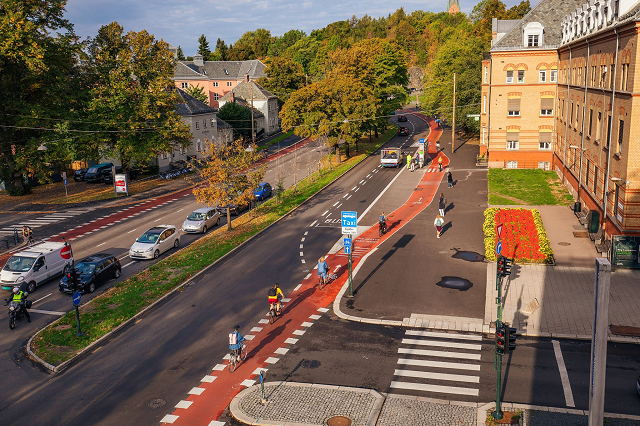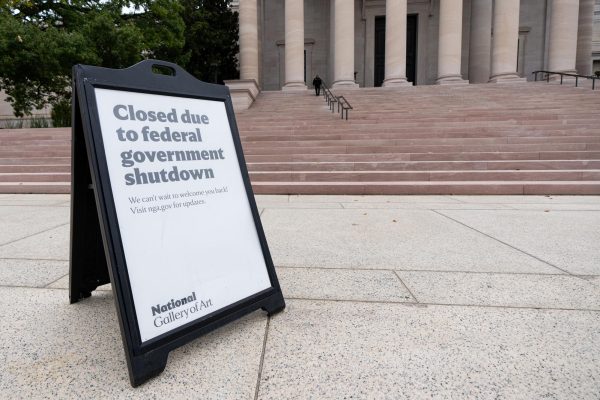Anti-Pedestrian Infrastructure: Why Roads Must Belong to People Again
OsloŌĆÖs City Ring Road after making many cyclist friendly improvements to its infrastructure. After a string of similar citywide changes, the majority of Oslo’s road are now a place where cars and bikers peacefully coexist.
January 19, 2023
Growing up, one of the biggest issues I faced was my dependence on my parents and the cars they drove in order to do anything, something many of my friends faced as well. Similar to others, I was only able to truly explore my city upon obtaining a driverŌĆÖs license. I thought for many years that this was just a reality of life, that most of being a kid meant being confined to oneŌĆÖs own house and that even going out to ride a bike was a privilege not granted by every parent.
As I got older and learned more about other cultures I realized that this was not a universal truth. In fact, in countries like the Netherlands almost half of all children donŌĆÖt get around by car, but by bike. In Japan, six year olds can be seen taking the train to elementary school. Meanwhile in 2016, the US had about 20 million children who traveled over two miles to school, over half of the students who were middle class or above rode in a personal vehicle to school and about 70 percent of children from low-income families took a school bus.┬Ā
This reliance on car-based transportation means that the majority of children are tied down in their movements to a personal vehicle they cannot drive, affecting their physical health. Consequently, in the United States only 24% of children ages 6 to 17 participate in the recommended 60 minutes of physical activity every day.
This over dependence on cars has real consequences, not only on the lives of children, but on the lives of everyone. Due to the car-centric city design that dominates the United States, it is almost impossible to leave the sprawling suburbs without a vehicle. The next time youŌĆÖre inside a car, I want you to pay attention to the sidewalksŌĆö or the lack thereofŌĆö upon leaving the suburbs. Often, what connects the county consists of highways, massive roads with dangerous speed limits, and unshaded, skinny sidewalks built dangerously close to cars speeding over 45 mph. ItŌĆÖs not surprising then, that most commuters do not find sidewalks to be an attractive form of alternative transportation. Even public transportation, when accessible, is often unreliable and underfunded.
Worst of all, this is an issue that unproportionately affects the lower class. Often, it is minimum wage workers who suffer the brunt of this issue as many must often pay out chunks of their salaries to ride sharing applications in order to make it back home due to poor route coverage.┬Ā In fact, a 2014 study from NYU found that a link existed between poor access to public transportation and higher rates of unemployment and decreased income within New York City. One of the biggest constraints to those struggling to climb the socioeconomic ladder could come from something as simple as not being able to afford a car, the insurance, and the maintenance fees that come with them.┬Ā
There was once a time where the U.S. wasnŌĆÖt anti-pedestrian: prior to the American dystopia of strip malls, superhighways, and Walmart parking lots, streets once brimmed with vendors selling goods, and everything a citizen needed was a block away. However, the 1920s marked a turn where automakers began to take measures alongside the government to rewrite the purpose streets served. Through ad campaigns, government lobbying, and even inventing the concept of ŌĆ£jaywalkingŌĆØ (prior to the 1920s it was nationally acceptable to cross the road wherever one pleasedŌĆö and it was a carŌĆÖs legal responsibility to avoid pedestrians) the culture out on the road shifted from being one for all to one for cars.
Creating a walkable city in a place like Miami seems like a true pipe dream. After all, there is a steep contrast between much more walkable cities in the northeast like New York and Boston which were constructed before many of the car-centric zoning laws of the 1920s, and newer southwestern cities like Huston and Miami. However, with data from the United States Environmental Protection Agency showing that the transportation sector is the biggest polluter across the US, the increase in traffic casualties nationwide, and the unavoidable increase in congestion that will follow population growth, making cities more walkable may be a necessary measure to take.┬Ā
Cities like Oslo have proved that change is possible, as it once saw five to seven traffic fatalities a year and decided to take action. To compare, 60 fatal car accidents happened in Miami in 2021 while having over half of OsloŌĆÖs population. After Oslo redesigned its roads in areas with high foot traffic, all the while expanding its system of bike lanes, it dropped its 2019┬Ā road user fatality rate down to zero. Not to mention, the city saw a 77 percent increase in bike traffic from 2014 to 2020.
While many challenges still lie in the way of transforming a car-centric city into one that is walkable and accessible to everyone, strides in cities across the world show that such a reality is possible. With concerted efforts to show politicians that this is an issue that matters to the people, we can set a new definition for what it means to have freedom of movement in our city.


















